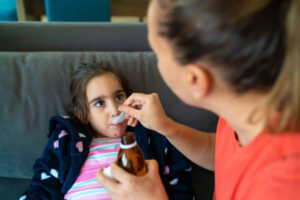Difference between a Normal and a Cancerous Cell?
Normal cells and cancer cells differ in several key ways:
- Cell growth: Normal cells grow and divide in an orderly way to keep the body healthy. Cancer cells, on the other hand, grow and divide in an uncontrolled manner, forming a mass of tissue called a tumour.
- Cell death: Normal cells die and are replaced by new cells when they become old or damaged. Cancer cells don’t die, they continue to grow and divide, leading to the buildup of abnormal cells.
- DNA damage: Normal cells have mechanisms to repair DNA damage that can occur as a result of environmental factors, such as radiation or chemicals. Cancer cells, however, may have mutations in the genes that control cell growth and division, making them less able to repair DNA damage.
- Ability to invade other tissues: Normal cells typically stay in the place where they belong and don’t invade other tissues. Cancer cells, on the other hand, can invade surrounding tissues and spread to other parts of the body through the bloodstream or lymphatic system, a process called metastasis.
- Tissue structure: Normal cells are usually well-organized and form a tissue that looks and functions as it should. Cancer cells, on the other hand, may form a disorganized mass of tissue that doesn’t function normally.
These differences are what makes cancer cells distinct from normal cells and contribute to the uncontrolled growth and spread of cancer. Understanding these differences is important for developing effective cancer treatments.
World’s Most Common and Deadliest Cancer
Lung cancer is considered to be one of the most common and deadliest types of cancer in the world. According to the World Health Organization (WHO), lung cancer is the leading cause of cancer-related death in both men and women.
There are several different types of lung cancer, including small cell lung cancer and non-small cell lung cancer. Non-small cell lung cancer is the most common type of lung cancer and is typically more difficult to treat than small cell lung cancer.
Smoking is the leading cause of lung cancer, but other risk factors include exposure to air pollution, radon gas, and asbestos.
Early detection of lung cancer is key to improving the chances of a successful outcome, but symptoms of lung cancer may not appear until the disease has advanced. Regular lung cancer screenings, such as low-dose computed tomography (CT) scans, can help detect lung cancer in its early stages when treatment is more likely to be successful.
If you have concerns about your risk of developing lung cancer or have symptoms that are concerning, it’s important to talk to your doctor. They can help you determine the best course of action for your individual needs and can refer you for further testing or treatment if necessary
Four Stages of Cancer
The four stages of cancer describe the progression of the disease from its earliest detectable form to its most advanced form. The four stages are:
- Stage I: In this stage, the cancer is small and has not spread beyond the area where it originated.
- Stage II: In this stage, cancer has grown larger and may have spread to nearby tissues or lymph nodes, but it has not spread to distant parts of the body.
- Stage III: In this stage, cancer has spread to regional lymph nodes or to nearby organs, but it has not yet spread to distant parts of the body.
- Stage IV: In this stage, cancer has spread to distant parts of the body, such as the liver, lungs, bones, or other organs. This is the most advanced stage of cancer and is often referred to as metastatic cancer.
It’s important to note that the stage of cancer can influence the treatment options available and the prognosis for the patient. Early detection and treatment can often lead to better outcomes for cancer patients, so it’s important to talk to your doctor about the best screening and early detection strategies for you.
Treatment of Cancer
Cancer treatment typically involves a combination of approaches that may include one or more of the following:
- Surgery: This is the removal of the cancerous tissue and is often used as the primary treatment for many types of cancer, especially those that are localized and have not spread to other parts of the body.
- Radiation therapy: This uses high-energy radiation to destroy cancer cells and shrink tumours. It may be used before or after surgery, or as a standalone treatment.
- Chemotherapy: This involves the use of drugs to destroy cancer cells. It may be given orally, intravenously, or topically, depending on the type of cancer and the stage of the disease.
- Immunotherapy: This is a type of cancer treatment that helps the body’s immune system to fight cancer. It may be used alone or in combination with other treatments, such as surgery or chemotherapy.
- Hormonal therapy: This type of treatment is used for cancers that are sensitive to hormones, such as certain types of breast cancer or prostate cancer. It involves the use of drugs that interfere with the production or action of hormones in the body.
- Targeted therapy: This type of treatment uses drugs that specifically target the cancer cells and their unique properties, rather than affecting normal, healthy cells.
The choice of treatment will depend on the type and stage of cancer, the patient’s overall health, and other factors. A team of specialists, including oncologists, surgeons, radiation therapists, and other healthcare professionals, will work together to develop a personalized treatment plan for each patient.
How to Counter Side Effects of Treatment Methods
Many cancer treatments can have side effects. The type and severity of the side effects will depend on the specific treatment, the dose and frequency of treatment, and the individual patient’s health and medical history. Some common side effects of cancer treatment include:
- Fatigue: Many cancer patients experience fatigue during treatment, which can be severe and long-lasting.
- Nausea and vomiting: Chemotherapy can cause nausea and vomiting, especially during the first few days of treatment. Anti-nausea medications can be prescribed to help manage these symptoms.
- https://amzn.eu/d/dI3jKF1

- Hair loss: Radiation therapy and chemotherapy can cause hair loss, which may be temporary or permanent.
- Skin irritation and redness: Radiation therapy can cause skin irritation and redness in the treated area.
- Neuropathy: Chemotherapy can cause nerve damage, which can result in numbness, tingling, and pain in the hands and feet.
- Anaemia: Cancer treatment can cause anaemia, a condition in which there is a reduction in the number of red blood cells.
- Changes in sexual function: Cancer treatment can affect sexual function in both men and women.
To minimize side effects, many patients are given medications to help manage specific symptoms and to support their overall well-being. Patients are also encouraged to communicate openly with their healthcare team about their experiences and any concerns they may have so that adjustments can be made to their treatment plan as needed. In addition, supportive care services, such as physical therapy, rehabilitation, and counselling, may be recommended to help patients cope with the physical and emotional effects of cancer treatment.
How to Prevent Patients from Infections
There are several ways to prevent infections, including:
- Wash your hands regularly: Regular and thorough hand washing is one of the best ways to prevent the spread of infections.
- Practice good hygiene: Cover your mouth and nose when you cough or sneeze, and dispose of tissues properly. Avoid sharing personal items, such as towels and toothbrushes, with others.
- Get vaccinated: Vaccines are available to protect against many types of infections, including the flu, pneumococcal disease, and hepatitis B.
- Avoid close contact with people who are sick: If you are around someone who is sick, try to avoid close contact and minimize the time you spend around them.
- Cook food thoroughly: Cook meat, poultry, and eggs to the appropriate temperature to kill harmful bacteria and parasites.
- Drink safe water: Make sure that the water you drink is clean and safe by using a water filter or boiling the water if necessary.
- Avoid touching your face: Touching your face, especially your mouth, nose, and eyes, can transfer germs and increase the risk of infection.
It’s important to remember that preventing infections is an ongoing process and that it’s important to continue to follow good hygiene practices even after you have been vaccinated or recovered from an illness. Additionally, if you have a weakened immune system or are at increased risk of infection, it’s important to talk to a healthcare professional about additional steps you can take to protect yourself.
- Preventive Measures to Safeguard against Cancer Including Use of Household Items
There are several lifestyle changes and habits you can adopt to help reduce your risk of developing cancer, including:
- Eating a healthy diet: A diet that is rich in fruits, vegetables, whole grains, and lean protein can help reduce your risk of cancer. Limit your intake of processed and red meats, and avoid sugary drinks and foods high in added sugars.
- Maintaining a healthy weight: Being overweight or obese can increase your risk of certain types of cancer. Maintaining a healthy weight through regular physical activity and a balanced diet can help reduce your risk.
- Not smoking: Smoking is the leading cause of preventable deaths worldwide, and is a major risk factor for a variety of cancers, including lung, throat, and bladder cancer. If you smoke, quitting is the best thing you can do to reduce your risk of cancer.
- Limiting alcohol consumption: Excessive alcohol consumption can increase your risk of several types of cancer, including breast, liver, and colorectal cancer. If you choose to drink, limit your alcohol consumption to no more than one drink per day for women and two drinks per day for men.
- Protecting your skin from the sun :https://amzn.eu/d/7fTygjn

- Excessive sun exposure can increase your risk of skin cancer. Protect your skin by wearing protective clothing, using sunscreen with a high SPF, and seeking shade when the sun is strongest.https://amzn.to/3FQi3U4

- Avoiding exposure to known carcinogens: Certain household and workplace chemicals, such as formaldehyde, benzene, and asbestos, have been classified as carcinogens. Minimize your exposure to these and other toxic chemicals as much as possible.
- Getting regular check-ups: Regular check-ups and screening tests can help detect cancer early when it is most treatable. Talk to your doctor about the appropriate screening tests for your age, gender, and family history.
It’s important to remember that adopting a healthy lifestyle is not a guarantee against cancer, but it can help reduce your risk. If you have concerns about your risk of developing cancer or have any symptoms that persist, it’s important to talk to your doctor. They can help you understand your individual risk and recommend the best course of action for your individual needs.
Does the Newborn also Carry the Symptoms of the Parents?
Inherited genetic mutations can increase a person’s risk of developing certain types of cancer. However, it’s important to note that the majority of cancers are not caused by inherited genetic mutations.
In some cases, cancer can be passed from parent to child through inherited genetic mutations. For example, inherited mutations in the BRCA1 and BRCA2 genes are associated with an increased risk of breast and ovarian cancer.
However, it’s also possible for cancer to develop in a newborn without a genetic predisposition. In some cases, a newborn may be exposed to cancer-causing substances in the womb or may develop cancer as a result of changes that occur in their DNA after birth.
If you have a family history of cancer or are concerned about the risk of passing cancer to your children, it’s important to talk to your doctor. They can help you understand your individual risk and recommend the best course of action for your individual needs.
Cancer in Children is Easily Curable or Just like in Adults Complications Exist in Children
The treatment and prognosis of childhood cancers can vary greatly depending on the type of cancer and the stage at which it is diagnosed. In general, childhood cancers are more likely to be curable than cancers that develop in adults.
Childhood cancers tend to respond well to treatment, and many children with cancer can be cured. This is because childhood cancers are often diagnosed at an early stage, and children’s bodies are more resilient and better able to tolerate the side effects of treatment.
However, treatment for childhood cancers can still have serious side effects and long-term complications, such as developmental delays, growth problems, and secondary cancers.
The specific treatment plan and prognosis for a child with cancer will depend on several factors, including the type and stage of cancer, the child’s age and overall health, and the side effects and risks associated with the treatment options.
If your child has been diagnosed with cancer, it’s important to work closely with their healthcare team to develop a treatment plan that is right for them. This may involve a combination of surgery, chemotherapy, radiation therapy, and/or other treatments, as well as close monitoring to help ensure the best possible outcome.


